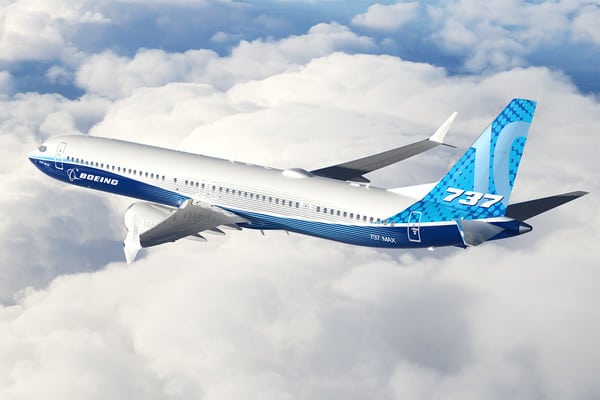Aerospace
This firm has awarded Boeing a new contract for up to 150 B737 max planes.

- Purchase includes firm order and options for 737-8-200 and 737-10 airplanes
- IAG selects the high-capacity and largest 737 citing airplane’s additional seats and environmental performance
- Fuel efficient family of airplanes will further the IAG´s sustainability goals
Boeing [NYSE: BA] and International Airlines Group (IAG) have placed an order for 50 737-8-200s and 737-10s, with an additional 100 options.
“IAG’s short-haul fleet renewal includes the addition of new Boeing 737 aircraft. These aircraft are more fuel efficient than the ones they’ll replace, and they’ll help us meet our goal of generating net zero carbon emissions by 2050 “IAG’s CEO, Luis Gallego, declared as much. IAG will be able to outfit the 737-8-200 with up to 200 seats, enhancing income possibilities while also lowering fuel usage.
The 737-10, the family’s largest aircraft, transports up to 230 passengers in a single-class configuration and has a range of 3,300 miles. The fuel-efficient plane can fly through 99 percent of single-aisle airports. routes, including 757-based routes.
“IAG has invested in a sustainable and profitable future with the selection of the 737-8-200 and larger 737-10, since both variants will dramatically cut operating costs and CO2 emissions,” said Stan Deal, president and CEO of Boeing Commercial Airplanes. “Today’s agreement for up to 150 737s, including 100 options, is a welcome addition of the 737 to IAG’s short-haul fleets and underlines our commitment to support the Group’s sustained network recovery and future expansion with Boeing’s unparalleled family of aeroplanes,” says the company.
The 737 features CFM International LEAP-1B engines, Advanced Technology winglets, and other enhancements to provide the most efficiency, reliability, and passenger comfort in the single-aisle industry. The 737 family of aeroplanes is 14 percent more fuel efficient than today’s most fuel-efficient Next-Generation 737s and 20 percent more fuel-efficient than the first Next-Generation 737s when they first entered service.
IAG announced a commitment for the 737 at the 2019 Paris Air Show, and today’s announcement is subject to IAG shareholders’ approval.
What is a Boeing P-8 airplane used for?
Boeing is a global aerospace leader that designs, manufactures, and services commercial aeroplanes, defence goods, and space systems for customers in over 150 countries. As a leading US exporter, the company taps into the expertise of a worldwide supply chain to propel its business forward. economic opportunities, long-term viability, and social effect Boeing’s diverse workforce is dedicated to leading with sustainability, inventing for the future, and developing a culture founded on the company’s core values of safety, quality, and integrity. At boeing.com/careers, you may join our team and find your calling.
Embraer receives First Passenger to Freight Conversion Deal for up to 10 E190F/E195F
Which is better f 35 or Gripen? comparison of US built F35 and SAAB 39E Gripen by Sweden

Aerospace
Boeing Transfers Rocket Stage to NASA, Paving Way for Human Moon Mission

Boeing has achieved a significant milestone by providing NASA with the second core stage of the Space Launch System (SLS) rocket.
This crucial component, crafted at NASA’s Michoud Assembly Facility (MAF), is set to propel the Artemis II crew into lunar orbit, marking humanity’s return to deep space after a 50-year hiatus.
The monumental Boeing-built rocket stage, the largest element of the Artemis II mission, will embark on a journey aboard the Pegasus barge, traveling 900 miles to NASA’s Kennedy Space Center.
Comparison of two legendary aircraft B777x vs B747 aircraft:Click here
Upon arrival, it will be meticulously integrated with other essential Artemis II components, including the upper stage, solid rocket boosters, and NASA’s Orion spacecraft within the iconic Vehicle Assembly Building. This intricate integration process is a vital step toward the eagerly anticipated Artemis II launch, slated for 2025.
“Boeing-built products helped land humankind on the moon in 1969, and we’re proud to continue that legacy through the Artemis generation,” remarked Dave Dutcher, vice president and program manager for Boeing’s SLS program. “Together, with NASA and our industry partners and suppliers, we are building the world’s most capable rocket and paving the way to deep space through America’s rocket factory in New Orleans.”
NASA, Lockheed Martin Reveal X-59 Quiet Supersonic Aircraft:Click here
The delivery of Core Stage 2 marks a significant achievement in the evolution of the SLS rocket. Towering over 200 feet and powered by four RS-25 engines, this core stage, coupled with two solid-fueled booster rockets, will generate a staggering 8.8 million pounds of thrust. This immense power is crucial to launching Artemis II and future missions into the vast expanse of space.
The SLS rocket stands unparalleled in its capability to transport both crew and substantial cargo to the moon and beyond in a single launch. Its extraordinary capacity will facilitate the delivery of human-rated spacecraft, habitats, and scientific missions to destinations including the moon and Mars, ushering in a new era of space exploration.
-

 Travel1 week ago
Travel1 week agoAir India to Expand US Operations with Three New Routes After a Decade
-

 Travel2 weeks ago
Travel2 weeks agoWhy We Should Avoid These Stamps in a Passport
-

 Airlines1 month ago
Airlines1 month agoInvestigations Reveal Fake Chinese Titanium in Boeing and Airbus Jets
-

 Tech4 weeks ago
Tech4 weeks agoChina’s CATL Plans 1,800-Mile Electric Plane Launch by 2027
-

 Airport3 days ago
Airport3 days agoTop 10 Largest Airports in the World by Size
-

 Aerospace4 weeks ago
Aerospace4 weeks agoChina’s Fighter Jets Turn Wings into Autonomous Drones
-

 Airlines4 days ago
Airlines4 days agoAir India Rolls Out A350s for Delhi-New York JFK and Newark Routes
-

 Defence3 weeks ago
Defence3 weeks agoBoeing Enhances Chinook with New Engines and Block II Upgrades at $96 Million







